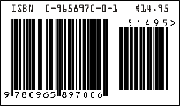bar code
 a.k.a. barcode, bar-code
a.k.a. barcode, bar-code A series of vertical lines printed on most physical merchandise, it's used to identify the product and its price (among other details). A scanner transmits the information to a cash register or computer for action (such as printing out a receipt).
Bar codes are used in a variety of ways, including linking medical records to a hospital patient's ID bracelet or tracking packages from overnight shippers. Considered to be the killer app of the digital age, bar-coded UPC symbols are used by more than one million companies worldwide to identify consumer products.
Historical perspective: Invented in South Beach, Miami, by Joseph Woodland and Bernard Silver, in 1949, it was patented in 1952 and first used commercially in 1974. In the early 2000s, a new technology employed lasers to tattoo fruits and vegetables with their names, identifying numbers, and countries of origin to help speed distribution. The marks are burned or "tattooed" onto the outer layer of the skin. The process, government approved and called safe by the industry, is designed to replace those tiny stubborn stickers that have to be scraped off. Since 9/11, the food industry has been testing this laser coding to help "track and trace" food supply. In fact, stores worldwide are testing tracing methods because in 2006, US federal regulations require all imported produce to be labeled with the country of origin. In Japan, apples have been sold with scannable bar coding etched into the wax on their skin. "With the right scanning technology, the produce could even be barcoded with lots of information: where it comes from, who grew it, who picked it, how many calories it has per serving, or you could even sell advertising space" quotes one food industry expert.


Edit Word